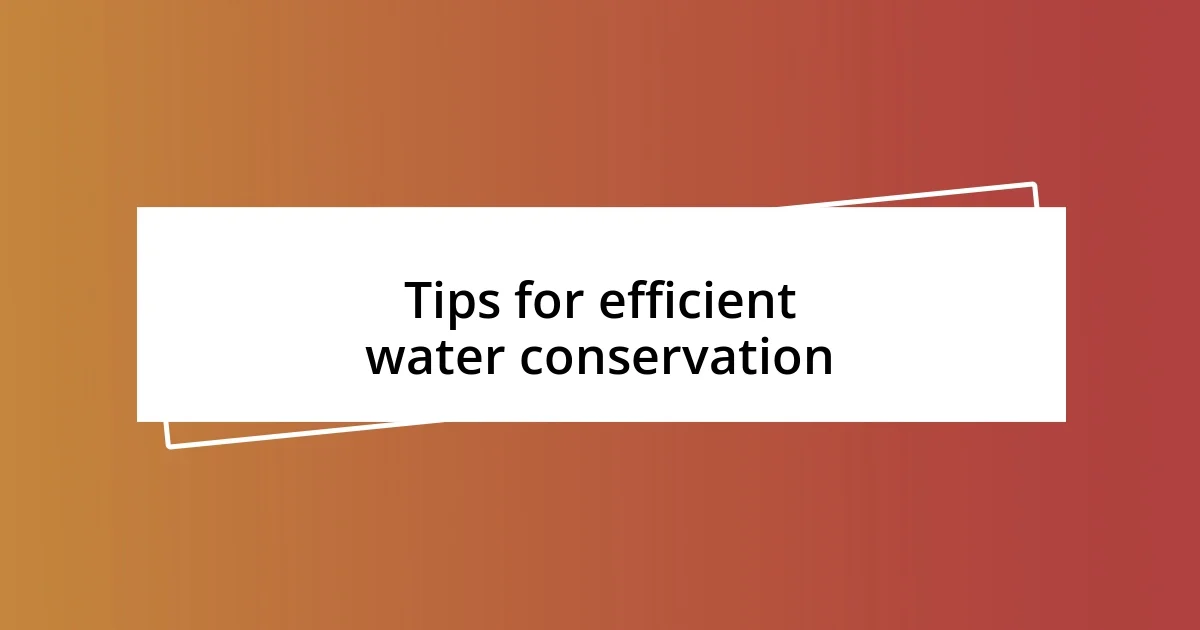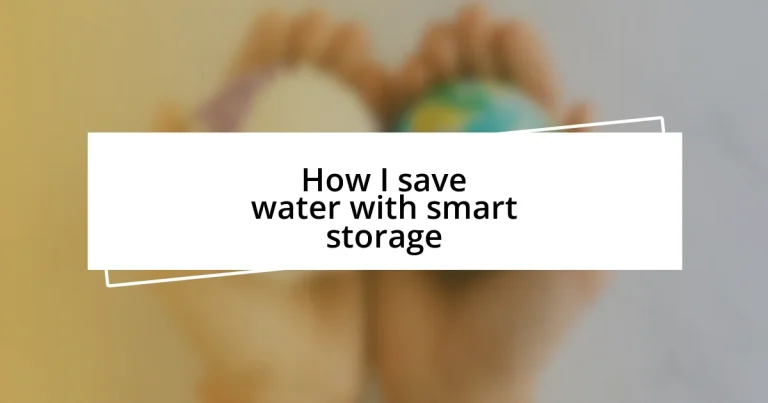Key takeaways:
- Smart water storage systems optimize water use by integrating technology like sensors and weather forecasts, minimizing waste and enhancing conservation efforts.
- The benefits include cost savings on utility bills, real-time monitoring of water usage, and proactive alerts for leaks, empowering individuals to take active roles in water conservation.
- Regularly checking for leaks, adjusting watering schedules, and collecting rainwater can significantly improve water efficiency and contribute to a sustainable lifestyle.

Understanding smart water storage
Smart water storage goes beyond just holding water; it’s about optimizing how we use it. From my experience, these systems can significantly minimize waste while ensuring that we always have access to what we need. Have you ever thought about how much water is lost from traditional tanks? I certainly did when I noticed leaks that quietly drained away resources.
Investing in advanced smart storage has transformed the way I manage water at home. For instance, I now use sensors that monitor water levels and pressure, allowing me to adjust usage based on real-time data. It’s fascinating to think about how technology not only aids in conservation but also gives us control over our consumption patterns.
One component that truly caught my attention is the integration of weather forecasts into these systems. When I realized that my smart reservoir could adjust its refill schedule based on expected rainfall, it felt like I had an ally in the fight against wastefulness. Doesn’t it feel reassuring to know that technology can support our environmentally conscious choices?

Benefits of smart water storage
The benefits of smart water storage extend far beyond mere convenience; they can genuinely enhance our daily lives. I remember the sense of satisfaction I felt when I first saw my water bill decrease after installing a smart storage system. It wasn’t just about saving money; it also made me feel empowered to take an active role in water conservation. Knowing that I was reducing my consumption while still having access to water made a huge psychological difference in how I approached my usage.
Here are some key benefits to consider:
- Cost Savings: Reduced utility bills as a direct result of optimized water usage.
- Environmental Impact: Decreased water waste supports sustainability efforts.
- Real-time Monitoring: Access to data on water levels and usage leads to smarter decisions.
- Convenient Adjustments: Automatic adjustments based on local weather forecasts save both water and effort.
- Proactive Alerts: Sensors notify you of leaks or maintenance needs, preventing costly damage.
Embracing smart water storage has turned conservation into an effortless routine for me, blending sustainability with a touch of technology. It’s fascinating how this approach creates a ripple effect—encouraging not only personal change but also fostering a stronger community commitment to preserving our most precious resource.

Choosing the right storage solution
Choosing the right storage solution can feel overwhelming, given the variety of options available. What I’ve found helpful is prioritizing what suits my specific needs. For instance, I realized early on that a tank’s capacity shouldn’t just match my usage but also adapt to seasonal changes. It’s also essential to consider the materials; while some options are more durable, others might offer better insulation or reduce evaporation.
In my journey towards effective water management, comparing different systems helped me make informed decisions. Enclosed reservoirs seemed ideal for reducing contamination, while open systems allowed for natural rainwater collection. I think it’s about balance—figuring out what mix of convenience, safety, and efficiency works best for my home. Which features would enhance your own water-saving efforts?
To assist in your decision-making process, I’ve put together a comparison table that outlines key features of popular smart storage solutions:
| Storage Type | Key Features |
|---|---|
| Enclosed Tanks | Durability, contamination protection, efficient water use |
| Open Cisterns | Natural rain collection, low maintenance, easy access |
| Modular Systems | Flexibility, scalable capacity, customizability |
| Smart Reservoirs | Integrates tech, weather-responsive, real-time monitoring |

Setting up smart water sensors
Setting up smart water sensors is surprisingly straightforward once you understand the basics. I remember the slight thrill I felt when I first unboxed my water sensor. It was as if I was unearthing a treasure that would help me make a real difference in my home. Installing these sensors can typically be done in a few simple steps, as most devices come with user-friendly guides. Ensuring they’re placed in areas prone to leaks or where water is stored was my top priority. What about you? Have you thought about where your sensors could be most effective?
Once I got my sensors in place, I was amazed at how they began sending notifications directly to my phone. This real-time monitoring gave me insights I never had before. I could see exactly when water levels were low or when a potential leak might arise. For example, last summer, one of my sensors alerted me to a slow leak under the kitchen sink. Catching it before it escalated saved me from not just wasted water but also costly repairs. Can you think of a spot in your home where a simple notification could save you a headache later?
For those new to this technology, I suggest starting with just one or two sensors to get the hang of things. Test their placement and adjust based on what works best for your routine. When I began, I was a bit overwhelmed by all the features the sensors had, but immersing myself gradually helped me appreciate how these little devices could automate my water conservation efforts. Do you ever find that technology can seem daunting? Trust me; once you see the benefits, it quickly becomes second nature.

Monitoring your water usage
Keeping an eye on your water usage has never been easier thanks to modern technology. I still remember the first time I truly tracked my consumption; it was a bit eye-opening. I realized that some of my daily habits, like long showers or watering my garden mid-afternoon, were significantly affecting my water bill. Just like that, I started asking myself, how can I be more conscious of my habits?
By integrating smart water meters, I began receiving daily summaries of my usage, which felt like a gentle nudge to stay mindful. What surprised me was how small adjustments—like flushing the toilet less often or fixing that drip in the sink—could lead to noticeable savings. Every bit counts, right? Reflecting on my experience, I often wonder if others realize just how impactful monitoring their water can be.
Utilizing apps that track water usage can also bring a layer of accountability. I’ve found it incredibly motivating to set goals and see my progress. For instance, I committed to reducing my water usage by 20% over the summer—seeing those numbers change each week spurred me on. Have you ever set such a goal? I can attest that once you start tracking, it becomes much easier to pick up on behaviors that waste water, paving the way for sustainable changes.

Tips for efficient water conservation
I’ve found that one of the simplest ways to conserve water is by checking for leaks regularly. You’d be surprised by how a minor drip from a faucet can waste gallons over time. I once had a shower head that seemed fine, but when I tested it, that small leak added up to a staggering amount of water wasted each month. Have you taken the time to inspect your fixtures? Setting aside just a few minutes each month for this can lead to significant savings.
Another tip I can’t stress enough is adjusting your watering schedule for gardens or lawns. I used to think more watering was better until I learned that many plants thrive on less frequent, deeper watering. By switching to an early morning schedule, I not only curtailed evaporation but noticed my plants were healthier too. This made me wonder, are you maximizing the efficiency of your gardening routine as I did?
Lastly, consider collecting rainwater for your outdoor needs. I installed a rain barrel a few years back, and it’s surprising how quickly it fills up. Now, I use that water for my garden, and it not only saves on my water bill but also makes me feel good about reusing a natural resource. Have you thought about creating a rainwater system in your home? It’s a small change with a big impact, and it’s so rewarding to see the difference it makes!














